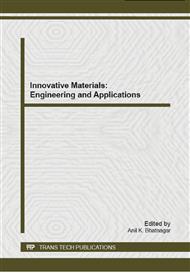[1]
Xing Ai, Hong Xiao. Cutting processing of Ceramic tool Materials. Beijing: Press of Mechanical Industry(1988).
Google Scholar
[2]
R.W. Steinbrech. Toughening mechanisms for ceramic materials. Journal of the European Ceramic Society 10 (3) 131–142(1992).
DOI: 10.1016/0955-2219(92)90026-a
Google Scholar
[3]
H.L. Liu, C.Z. Huang, J. Wang, X.Y. Teng. Fabrication and mechanical properties of Al2O3/Ti(C0. 7N0. 3) nano-composites. Materials Research Bulletin 41 (7) 1215–1224(2006).
DOI: 10.1016/j.materresbull.2006.01.014
Google Scholar
[4]
H.L. Liu. Study on the Fabrication and cutting performance of ceramic tool materials based on multi-phase and multi-scale nanocomposites. [D] 12-13(2005).
Google Scholar
[5]
Srolovirz D J, Anderson M P, Grest G S, et al. Grain growth in two dimensions. Scrip Metall 17, 241(1983).
Google Scholar
[6]
D. Fan and L. -Q. Chen. Computer simulation of grain growth using a continuum field model, Acta metal, 45611-622(1997).
Google Scholar
[7]
Mahis, K. W., Hanson, K., and Morrid, J. W. Jr., Comparative analysis of the cellular and Johnson-Mehl microstructures through computer simulation, Acta Metall., Vol. 28, No. 4, 443-453(1980).
DOI: 10.1016/0001-6160(80)90134-0
Google Scholar
[8]
Chen LQ, Yang W. Computer simulation of the domain dynamics of a quenched system with a large number of nonconserved order parameters: The grain-growth kinetics, Phys. Rev. B 50, 15752–15756(1994).
DOI: 10.1103/physrevb.50.15752
Google Scholar
[9]
D. A. Fan and L. Q. Chen. Diffuse-Interface Description of Grain Boundary Motion, Philos Mag. Lett., 75(4) , 187-196, (1997).
Google Scholar
[10]
Yoshihiro Suwa, Yoshiyuki Saitob and Hidehiro Onodera. Phase field simulation of grain growth in three dimensional system containing finely dispersed second-phase particles. Scripta Materialia, 55(4), 407-410(2006).
DOI: 10.1016/j.scriptamat.2006.03.034
Google Scholar
[11]
I. Steinbach, F. Pezzolla, B. Nestler, M. Seesselberg, R. Prieler, G. J. Schmitz and J. L. L. Rezende, A phase field concept for multiphase systems, Physica D, 94 , 135 – 147(1996).
DOI: 10.1016/0167-2789(95)00298-7
Google Scholar
[12]
A. Kazaryan, Y. Wang, S.A. Dregia and B.R. Patton, Generalized phase-field model for computer simulation of grain growth in anisotropic systems. Physical Review B, 61, 14275(2000).
DOI: 10.1103/physrevb.61.14275
Google Scholar
[13]
C. E. Krill and L. Q. Chen. Computer Simulation of 3-D Grain Growth Using a Phase-Field Model, Acta Mate, 50(12), 3057-3073(2002).
Google Scholar
[14]
N. Moelans, B. Blanpai, P. wollants. Pinning effect of second-phase particles on grain growth in polycrystalline films studied by 3-D phase field simulations, Acta Mater, 55, 2173-2183(2007).
DOI: 10.1016/j.actamat.2006.11.018
Google Scholar
[15]
Kunok Chang, Weiming Feng, Long-Qing Chen. Effect of second-phase particle morphology on grain growth kinetics, Acta Mater, 57, 5229-5236(2009).
DOI: 10.1016/j.actamat.2009.07.025
Google Scholar
[16]
Mark Miodownik, Elizabeth A. Holm and Gregory N. Hassold, Highly Parallel Computer Simulations of Particle Pinning: Zener Vindicated, Scripta Mat. 42, 1173(2000).
DOI: 10.1016/s1359-6462(00)00354-7
Google Scholar
[17]
S.P. Riege, C.V. Thompson and H.J. Frost. Simulation of the influence of particles on grain structure evolution in two-dimensional systems and thin films, Acta Mater. 47, 1879-1887(1999).
DOI: 10.1016/s1359-6454(99)00039-7
Google Scholar


